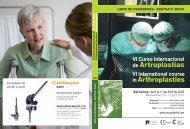cadera / hip - Active Congress.......
cadera / hip - Active Congress.......
cadera / hip - Active Congress.......
Create successful ePaper yourself
Turn your PDF publications into a flip-book with our unique Google optimized e-Paper software.
VIERNES / FRIDAY<br />
278<br />
13.00 - 14.30 h<br />
RODILLA / KNEE<br />
Complicaciones<br />
Complications<br />
Moderador / Moderator: Leo Whiteside<br />
EVALUATION OF THE<br />
PAINFUL KNEE AFTER TKA<br />
J. Romero, M.D.<br />
Endoclinic Zurich, Center for Arthroplasty<br />
and Joint Surgery,<br />
Klinik Hirslanden, Switzerland<br />
Total knee arthroplasty (TKA) is a most effective<br />
treatment for advanced degenerative<br />
joint disease of the knee. Although satisfactory<br />
results can be expected in most of the<br />
patients, occasionally the outcome may be<br />
compromised by pain and poor range of motion<br />
after uneventful surgery and postoperative<br />
course. Stiffness of the knee is a frustrating<br />
complication for both the patient and the<br />
surgeon. A variety of activities of daily living<br />
and the overall quality of life is compromised<br />
by limited fl exion and incomplete extension.<br />
Stiffness may or may not be accompanied<br />
by pain at rest, but the attempt to forcefully<br />
increase the arc of motion of a stiff knee is<br />
usually painful. Ambulating with a knee that<br />
does not fully extend increases the muscular<br />
work of walking and decreases endurance,<br />
particularly in the quadriceps muscle. Walking<br />
of a level surface is possible if the knee fl exes<br />
only 45° to 55° during swing phase. Ascending<br />
or descending stairs requires about 85°<br />
of fl exion. Standing from a chair is facilitated<br />
if the foot can be brought under the seat; this<br />
usually requires 95° of fl exion. The patients<br />
demands after total knee arthroplasty have<br />
increased over the last years since most of<br />
them enjoy bicycling, mountain hiking, skiing<br />
and other sports activities which require fl exion<br />
well beyond 90°. High fl exion angles are<br />
required by a variety of cultural and religious<br />
habits such as prayer (125°) and squatting<br />
for eating or hygiene (135°). Therefore the<br />
defi nition for stiffness is not absolute and<br />
depends on the patients demand. In practice,<br />
a patient who fl exes less than 100° or lacks<br />
more than 10° for full extension considers<br />
his surgery usually as a failure. If attempts<br />
at non-operative management such as pain<br />
medication, physiotherapy, and perhaps<br />
under certain conditions manipulation under<br />
anesthesia have failed, and the knee remains<br />
with poor range of motion, surgery may be<br />
the only option. If an operative treatment is<br />
considered it is mandatory to evaluate the<br />
underlying condition of the limited arc of motion.<br />
It may have a mechanical or a biological<br />
origin. If the main complaint is pain without<br />
loss of motion, the origin of pain is primarly<br />
mechanical, however psychological factors<br />
may also play a certain role. In any case<br />
evaluation of the painful total knee arthroplasty<br />
consists of a thorough history, as well<br />
as physical and several other invasive and<br />
non-invasive examinations, and laboratory<br />
and imaging testing.<br />
The painful knee without stiffness<br />
It is important to obtain the information from<br />
the patient on when he developed a painful<br />
knee after TKA. If the patient was never<br />
pain-free following surgery, diagnosis such<br />
as instability, prosthetic malpositioning and<br />
malsizing with soft tissue impingement,<br />
lateral patellar facet syndrome or patellar





